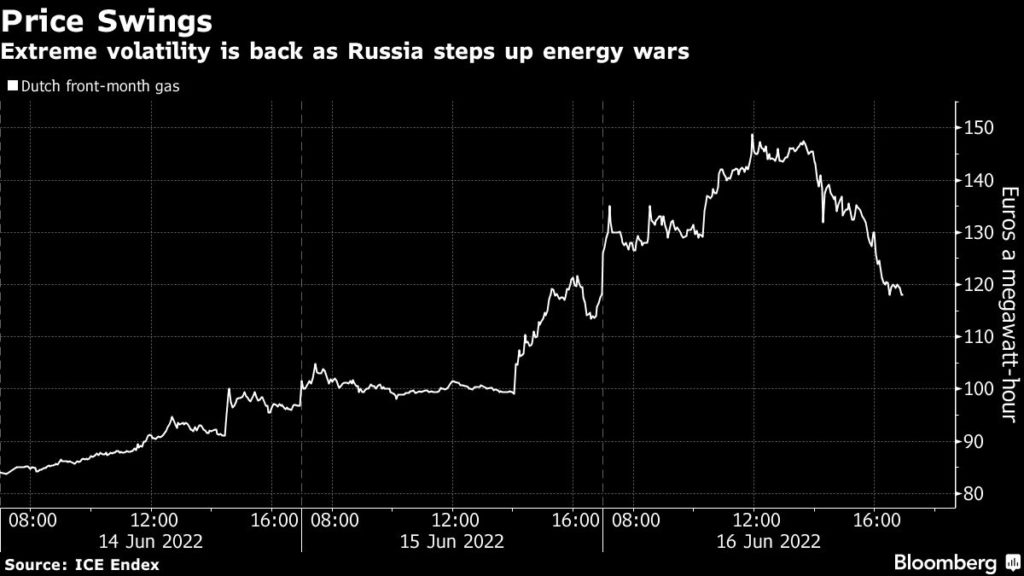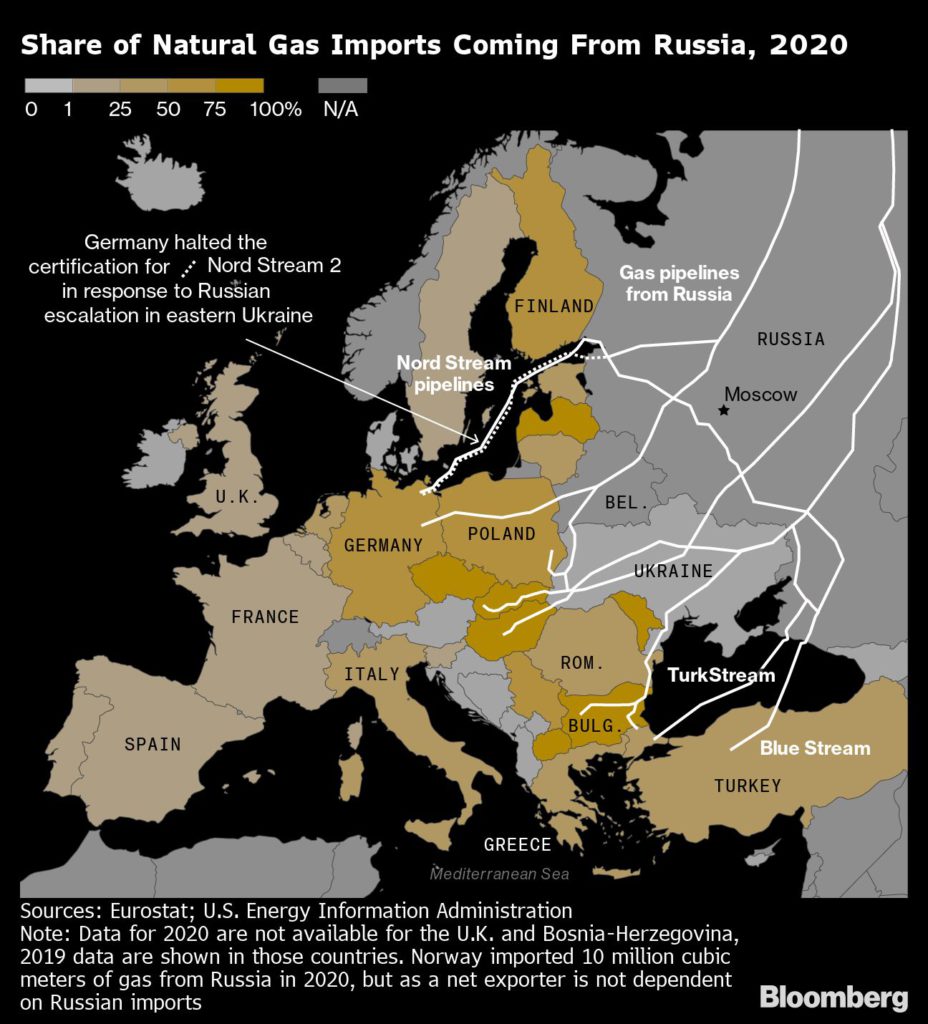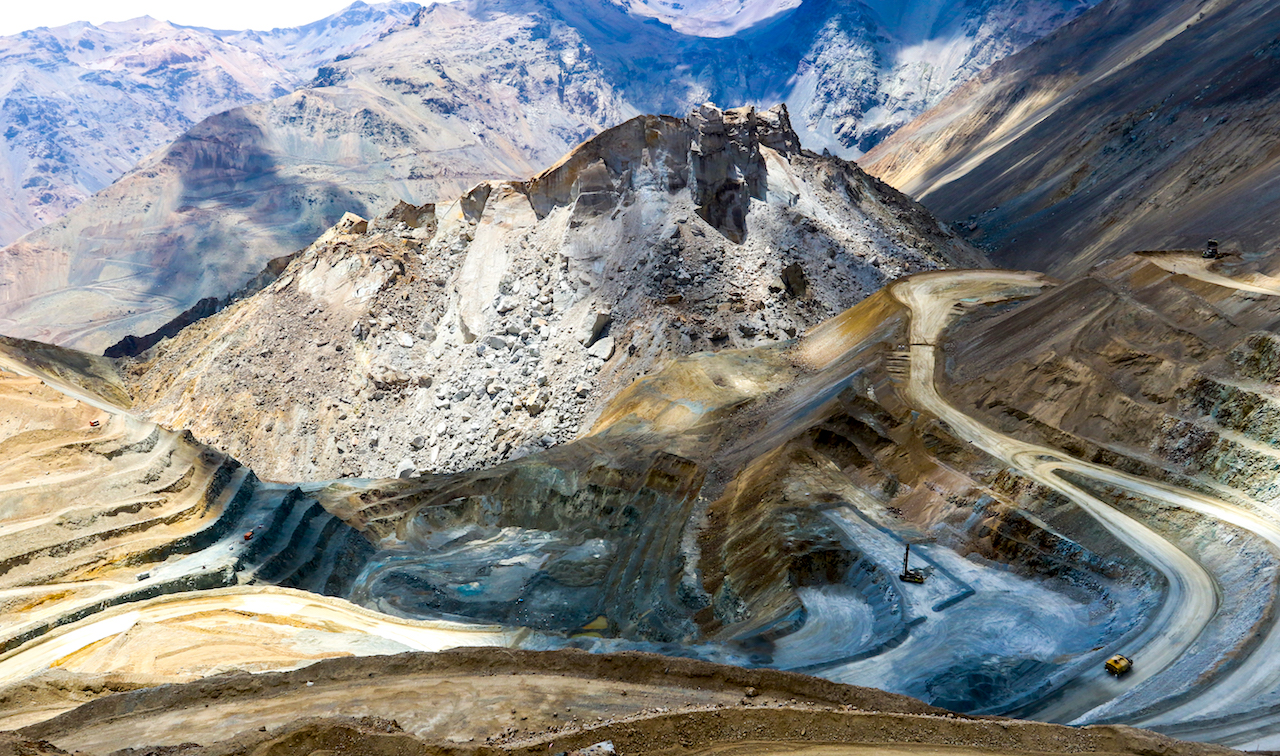European gas gyrates as Russian cuts escalate energy crisis

European gas prices gyrated as Moscow tightened its squeeze on crucial gas flows to the continent, forcing consumer nations to confront the prospect of keeping their economies running without Russian gas.
Benchmark futures jumped as much as 24%, before easing later in the day. The supply cuts are rippling through Europe, with companies including Eni SpA, Engie SA and Uniper SE saying they’re receiving less of the fuel. Germany accused Russia of curbing supplies via the Nord Stream pipeline to unsettle markets, challenging Gazprom PJSC’s claim that the halt was due to technical issues.
Europe has for months feared Russian supply cuts in retaliation for sanctions aimed at Moscow for its invasion of Ukraine. The latest crisis could hit key industries from chemicals companies to steelmakers, a body blow for a region that’s already struggling with surging inflation and meager growth.

Moscow’s move prompted Germany’s top energy regulator to urge consumers and industry to scale back consumption to help fill storage sites ahead of the next heating season. Gas rationing is becoming a real prospect, and could easily happen if the Nord Stream route is fully halted.
“If flows stay as they are it will be more difficult and expensive to fill storage,” said Jonathan Stern, a distinguished research fellow at the Oxford Institute for Energy Studies. “If Nord Stream totally shuts, that is even more difficult, but nothing dramatic starts to happen until winter.”
The cuts also come as German Chancellor Olaf Scholz, French President Emmanuel Macron and Italian Prime Minister Mario Draghi arrived in Kyiv Thursday for talks with President Volodymyr Zelenskiy in the highest-profile visit to the country since Russia invaded at the end of February. The Kremlin said on Thursday the supply reductions were “not deliberate.”
The region’s benchmark contract surged to almost 149 euros a megawatt-hour, the highest for a most-active contract since prices reached a record in early March. Futures later pared gains, closing 3.4% higher at 124.4 euros a megawatt-hour.
Cash collateral
Higher prices mean energy firms have to put down more cash as collateral to back their trades. Right after Russia’s invasion of Ukraine, companies were forced to borrow billions to pay down the so-called margin calls. That could be an issue again.
“At these elevated levels the margin calls are so high,” said Nick Campbell, a director at Inspired Plc. Some traders may “want to sell to avoid a large margin call at the end of the day.”
Russia has been slowly tightening its grip on European energy markets, halting gas shipments to buyers in Poland, Bulgaria, Finland, Denmark and the Netherlands due to a dispute over President Vladimir Putin’s demand that the fuel should be paid for in rubles. Now even the countries that found workarounds to keep Russian gas flowing are getting cut out.
Berlin has already triggered the first stage of a three-step emergency plan to ensure security of supply, and may be forced to go further if the cuts deepen. The country, however, has said it can for now secure alternate volumes.
Siemens turbines
The supply cut announced by Russia on Wednesday follows reductions the previous day after Gazprom cited issues with repairs of turbines produced by Siemens. Western sanctions on Russia have left equipment key for the functioning of the Nord Stream gas pipeline stuck abroad.
“As of now, there is no solution for the issue,” Gazprom Chief Executive Officer Alexey Miller said Thursday.
It’s unclear when the pipeline will be back at full capacity, and the link is also scheduled to undergo maintenance next month, prompting speculation of a prolonged shutdown. But S&P Global Commodity Insights said their base case scenario is a return of full Nord Stream flows in August.
Still, “there is significant risk they remain low,” making Europe’s targets for next-winter gas inventories difficult to achieve, said S&P Analyst James Huckstepp.
While Gazprom could use spare capacity on pipelines crossing Ukraine to supply European customers, the Russian gas giant hasn’t opted for that solution. Miller said the company is benefiting from soaring prices in Europe even if shipments to its biggest market are now lower.

The latest move adds to a supply crunch already created by an outage in the US. A major liquefied natural gas export facility in Texas — a vital source of supply for Europe — will remain shut for longer than initially anticipated following a fire last week.
The continent may now have to compete more fiercely with Asian buyers to secure spare LNG supply as they rush to replenish storage facilities before demand peaks again in the winter.
Delays in filling inventories could lead to a tough winter, especially if Russian supply at the time continues to be curbed. “Gas prices will continue in the winter to be very high,” Marco Alvera, former chief executive officer of Italian network operator Snam SpA, said at a conference on Thursday.
(By Elena Mazneva, Verity Ratcliffe and Isis Almeida)
More News
{{ commodity.name }}
{{ post.title }}
{{ post.date }}

Comments